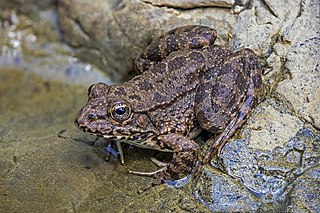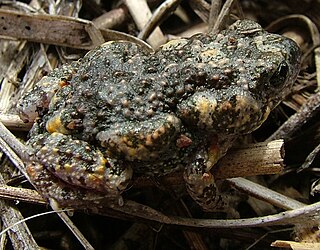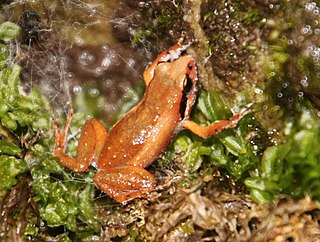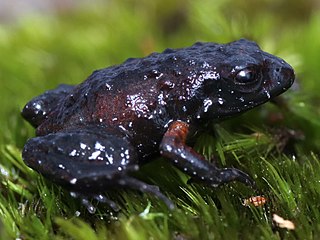
True frogs is the common name for the frog family Ranidae. They have the widest distribution of any frog family. They are abundant throughout most of the world, occurring on all continents except Antarctica. The true frogs are present in North America, northern South America, Europe, Africa, and Asia. The Asian range extends across the East Indies to New Guinea and a single species has spread into the far north of Australia.

Gardiner's Seychelles frog is a small frog of the family Sooglossidae and endemic to the Seychelles. It is named after John Stanley Gardiner, English zoologist and oceanographer.

The wrinkled toadlet is a species of small, ground-dwelling frog in the family Myobatrachidae It is endemic to Australia. It is also commonly called the small-headed toadlet, red-groined toadlet or the chubby gungan.

Leptobrachium hasseltii is a species of toad found in Southeast Asia. This frog named after Dutch Naturalist Johan Conrad van Hasselt. According to the current understanding, this species is known with certainty only from Java, Madura, Bali, and Kangean Islands, Indonesia. The species is also commonly reported to occur in the Philippines, but these are believed to refer to another, unnamed species.
The Imienpo Station frog is a species of frog found in Northeast Asia. It has sometimes been regarded as a subspecies of the Japanese wrinkled frog, Glandirana rugosa, with which it shares many characteristics. It is found throughout the Korean Peninsula and adjacent northeast China. It is speculated to be or have been present in the Russian Primorye region as well, but attempts to find it there have been unsuccessful.

Arthroleptella is a genus of frogs known as moss frogs in the family Pyxicephalidae. The ten species of this genus are endemic to South Africa.

Limnonectes namiyei is a species of frog in the family Dicroglossidae. It is endemic to Okinawa Island, Japan. It is named after Motoyoshi Namiye, a Japanese naturalist and herpetologist. Its common name is Okinawa wart frog or Namiye's frog; the latter name is also spelled Namie's frog.

The Japanese brown frog is a species of frog in the family Ranidae, endemic to Japan. Its natural habitats are temperate grassland, rivers, swamps, irrigated land, and seasonally flooded agricultural land.
Glandirana minima is a species of frog in the family Ranidae. It is endemic to the eastern parts of the Fujian province, China,. Its natural habitats are rivers, swamps, freshwater marshes, intermittent freshwater marshes, ponds, and irrigated land. It is threatened by habitat loss.

The Daruma pond frog is a species of frog in the family Ranidae. It has two subspecies, P. porosus porosus and P. porosus brevipodus. It is endemic to Japan. The average size of males is 3.5 to 6.2 cm, while females are from 3.7 to 7.3 cm.
The Otton frog, is a species of frog in the family Ranidae. It is endemic to the islands of Amami Ōshima and Kakeromajima in the Ryukyu Islands, Japan. Its natural habitats are subtropical or tropical moist lowland forests, freshwater marshes, and intermittent freshwater marshes. Once considered a delicacy as a source of food, it is now threatened by habitat loss through deforestation, and predation by introduced mongooses.

The Tago's brown frog or simply Tago frog is a species of frog in the family Ranidae endemic to Japan. It is widely distributed within Japan and found on Honshu, Shikoku, and Kyushu, as well as on some outlying islands. There are two subspecies:
Glandirana tientaiensis, also known as Tiantai frog and Tientai rough-skinned frog, is a species of frog in the family Ranidae. Its name refers to its type locality, Tiantai. It is endemic to eastern China and is only known from Zhejiang and south-eastern Anhui provinces.

Glandirana is a genus of true frogs found in the East Asia. The name means ‘glandular frog’.
Parthenogenesis is a form of reproduction where eggs develop without fertilization, resulting in unisexual species. This phenomenon is closely related with reproductive modes such as hybridogenesis, where fertilization occurs, but the paternal DNA is not passed on. Among amphibians, it is seen in numerous frog and salamander species, but has not been recorded in caecilians.

Arthroleptella rugosa is a species of frog in the family Pyxicephalidae. It is endemic to South Africa and only known from the Klein Swartberg Mountain, an inselberg near Caledon, Western Cape. The specific name rugosa is Latin for wrinkled or rough and refers to the rough appearance of this species as well as its rough sounding advertisement call. Accordingly, the common name rough moss frog has been suggested for it.

Glandirana susurra is a species of frog in the family Ranidae, the "true frogs". It is endemic to Sado Island, Japan. It is the only endemic amphibian of the island. It is genetically close to the widespread Glandirana rugosa, but it is morphologically distinguishable and postzygotically isolated from the latter species.













